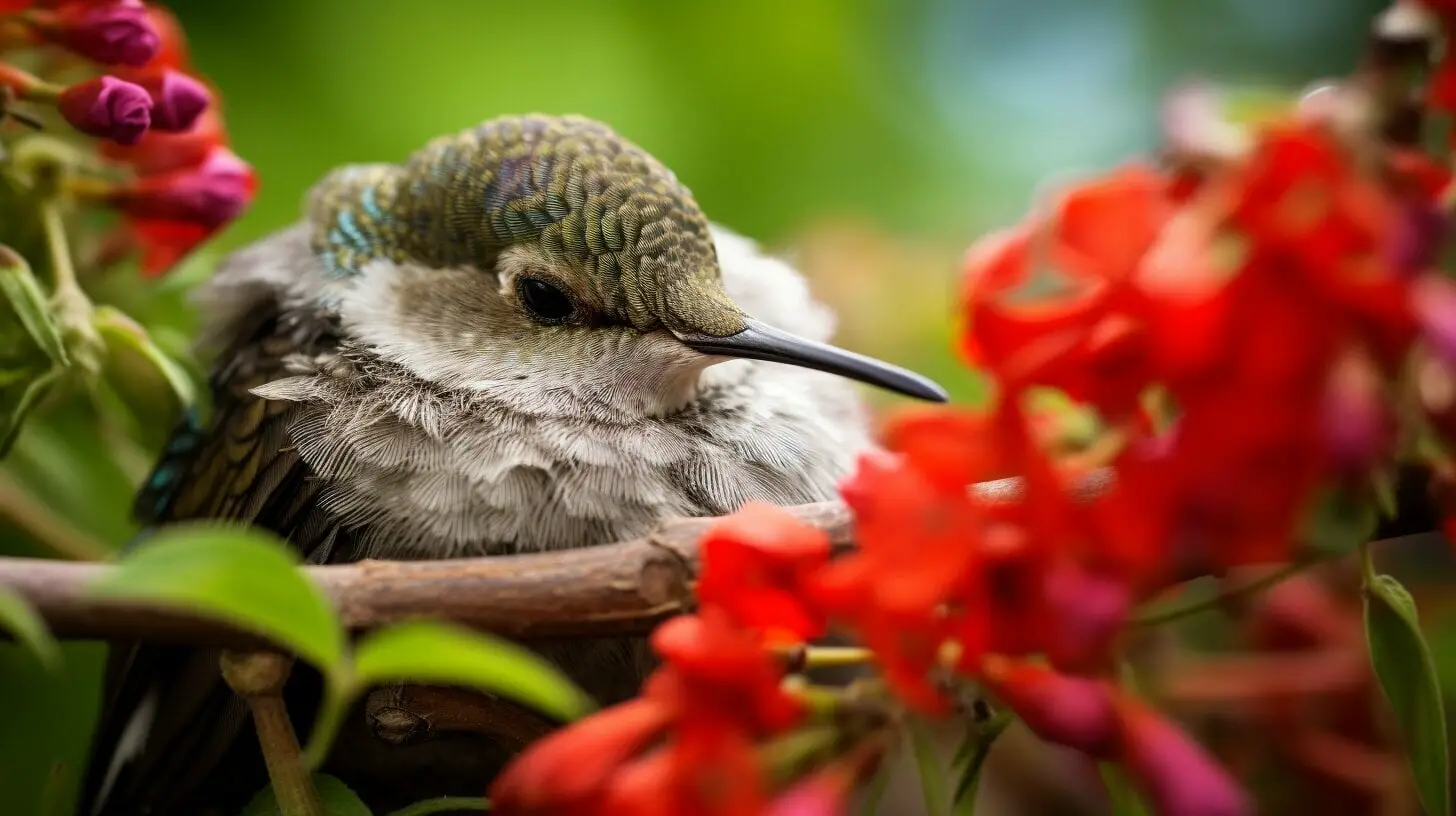Hummingbirds are fascinating creatures known for their tiny size and incredible speed in flight. But have you ever wondered how they sleep? Despite their high energy, hummingbirds do need to rest to maintain their health and well-being. In this article, we’ll explore the sleeping patterns and mechanisms of these unique birds, uncovering their secrets of slumber.
Key Takeaways:
- Hummingbirds have unique sleeping patterns and behaviors.
- They sleep while perched and can maintain balance and stability during sleep.
- Hummingbirds have adapted to their environment to ensure safe and restful sleep.
- Understanding hummingbird sleep can help with their conservation efforts.
Understanding Hummingbird Sleep Behavior
Hummingbirds are unique in their sleep behavior, with daily patterns and preferences that differ significantly from those of other birds. They typically rest by perching on a branch or wire, with their eyes closed and their bodies relaxed. However, their resting habits and sleep behavior vary depending on factors like age, environmental conditions, and food availability.
Hummingbird Resting Habits
Hummingbirds prefer to rest on perches that are high up, such as tree branches or telephone wires. They also tend to choose perches that provide good visibility of their surroundings, enabling them to detect potential predators or food sources. While resting, hummingbirds often tuck one foot up into their feathers to conserve heat, and they may also hunch their shoulders to reduce heat loss through their feathers.
Sleep Behavior of Hummingbirds
Unlike other birds that have a deep sleep and a light sleep, hummingbirds, like humans, enter into a slow wave sleep and rapid eye movement (REM) sleep. During REM sleep, their body temperature drops by as much as 10-15 degrees Fahrenheit, and their heart rate slows to conserve energy. Due to their small size, hummingbirds only need a few seconds of REM sleep at a time, and they may wake up and resume activity several times during the night.
Hummingbirds also have the unique ability to sleep while perched, which is made possible by a specialized tendon in their legs that locks their toes around the perch when their legs are bent. This mechanism allows them to maintain balance and stability, even during deep sleep. In addition, hummingbirds have the ability to enter a state of torpor, in which their metabolic rate slows down to conserve energy during periods of low activity or food scarcity.
Their sleep behavior can also be affected by environmental factors, such as temperature, wind, and rain. During cold weather, they may enter a deeper sleep to conserve energy, while during hot weather, they may sleep lightly to avoid overheating.
Conclusion
Hummingbirds’ unique sleep behavior is a fascinating area of study that offers valuable insights into how birds can adapt to changing environmental conditions. Understanding their sleep patterns and preferences can also help us to better conserve their habitats and ensure their survival in the face of ongoing environmental challenges.
Do Hummingbirds Sleep at Night?
One of the most common questions about hummingbird sleep is whether they sleep at night. The answer is yes, hummingbirds do sleep at night, but their sleep patterns are different from other birds.
Hummingbirds are diurnal birds, meaning they are most active during the day and sleep at night. However, they do not sleep for long periods like other birds. Instead, hummingbirds take several short naps throughout the day and night, totaling around 12 hours of sleep per day.
During the night, hummingbirds enter a state of torpor, which is a type of deep sleep that involves a significant decrease in their metabolic rate. Torpor helps hummingbirds conserve energy and survive the cooler nighttime temperatures.
Interestingly, hummingbirds can enter torpor even during the day if they are experiencing stressful conditions, such as food scarcity or extreme heat. This ability to enter torpor at any time is a unique adaptation that allows hummingbirds to conserve energy and endure challenging environments.
Exploring Hummingbird Sleep Mechanism
Hummingbirds have several unique physiological features that enable them to sleep while perched. One of these features is their ability to lock their legs in place, allowing them to maintain balance and stability during sleep. Additionally, hummingbirds have a special tendon in their legs that allows them to remain perched even when their muscles are completely relaxed.
Another key aspect of hummingbird sleep mechanism is their ability to enter a state of torpor. During torpor, hummingbirds significantly reduce their metabolic rate, heart rate, and body temperature. This allows them to conserve energy and survive when food is scarce. During torpor, hummingbirds also experience a type of sleep known as slow-wave sleep, which is characterized by high-amplitude brain waves.
Exploring Hummingbird Sleep Mechanism: The Biology of Torpor
During torpor, hummingbirds reduce their metabolic rate by up to 95%, which is one of the most significant reductions known in the animal kingdom. To achieve this state, hummingbirds undergo several physiological changes, such as:
| Physiological Change | Description |
|---|---|
| Reduction in heart rate | Hummingbirds can reduce their heart rate by up to 95% during torpor. This helps conserve energy and allows them to survive when food is scarce. |
| Decrease in body temperature | Hummingbirds can lower their body temperature by as much as 50 degrees Fahrenheit during torpor. This also helps conserve energy and reduces their need for food. |
| Paralysis of digestive system | Hummingbirds completely shut down their digestive system during torpor to conserve energy and reduce the need for food. |
Despite these significant physiological changes, hummingbirds can quickly come out of torpor when necessary, such as when they need to feed or respond to a threat.
Hummingbird Sleep Cycles
Hummingbirds have a unique sleep cycle that differs from most other bird species. They sleep approximately 50% less than other birds and tend to sleep more in the day than at night.
Their sleep cycles typically consist of short naps that last only a few seconds to a minute, followed by brief periods of wakefulness. During these wakeful periods, hummingbirds may engage in grooming or feeding behaviors.
In addition, hummingbirds have the ability to enter a state of torpor, which is a state of decreased physiological activity. Torpor allows hummingbirds to conserve energy during periods of low food availability or cold weather. During torpor, hummingbirds may appear to be asleep, but they are actually in a state of lowered metabolic rate.
The frequency and duration of hummingbird sleep cycles can vary based on factors such as age, gender, and environmental conditions. Juvenile hummingbirds may sleep more than adults, and females may sleep more during the breeding season. Environmental factors such as temperature, food availability, and predators can also impact their sleep behavior.
Overall, hummingbirds have a unique sleep cycle that varies based on their individual needs and environmental conditions. Understanding their sleep patterns is essential for their survival and well-being.
Do Hummingbirds Dream?
Hummingbirds are known for their unique sleep behavior, but one question that remains unanswered is whether they dream during their slumber. While no studies have definitively proven that hummingbirds dream, there is evidence to suggest that they may experience some form of dreaming.
Like many birds, hummingbirds undergo rapid eye movement (REM) sleep during their slumber. This phase of sleep is often associated with dreaming in mammals, making it possible that hummingbirds also experience some form of dreaming. Additionally, hummingbirds have been observed exhibiting behaviors during sleep that could be interpreted as dreaming, such as chirping or twitching their wings.
Despite these observations and theories, more research is needed to fully understand whether hummingbirds dream and what exactly their dreams may entail.
Factors Affecting Hummingbird Sleep
Hummingbirds are highly adaptable birds, but their sleeping patterns can be influenced by various factors that affect their day-to-day activities. Understanding these factors is crucial in ensuring their survival and well-being.
Environmental Factors
Weather conditions such as temperature, humidity, and wind can affect the quality of a hummingbird’s sleep. High temperatures can lead to dehydration and increased metabolic rates, while strong winds can make it difficult for hummingbirds to maintain their balance and stability during sleep. A comfortable temperature range and a calm environment are optimal for their restful sleep.
“Hummingbirds need to conserve their energy for their high metabolic rate and constant flight, so a good sleep is essential for their survival.”
Food Availability
The availability of food resources can have a significant impact on hummingbird sleep patterns. During periods of drought or food scarcity, hummingbirds may have to spend more time foraging for food, reducing their sleep time and quality. Conversely, a surplus of food can provide them with the necessary energy to sleep more soundly and for longer periods.
Territorial Disputes
Hummingbirds are highly territorial birds and can become aggressive towards other hummingbirds in their vicinity. Territorial disputes can disrupt their sleep and cause stress, reducing their overall sleeping time and quality.
By understanding the factors that affect hummingbird sleep, we can take steps to create a conducive environment for their restful slumber and ensure their survival and well-being.
Environmental Adaptations for Sleep
Hummingbirds have evolved unique environmental adaptations to ensure safe and restful sleep. Their ability to enter a state of torpor, a condition that slows down their metabolic rate and conserves energy, is one such adaptation.
During torpor, hummingbirds reduce their body temperature and heart rate, and enter a state of deep sleep that allows them to conserve energy and survive periods of low food availability. Additionally, hummingbirds use a variety of perching positions to ensure stability and minimize the risk of falling during sleep.
Hummingbirds also carefully choose their sleeping locations, preferring areas that offer protection from predators and unfavorable weather conditions. For instance, some species of hummingbirds build nests in concealed locations, such as under leaves or on the branches of thorny plants, to avoid detection by predators.
In addition, hummingbirds have developed a unique muscle locking mechanism that allows them to maintain balance and stability while perched. This mechanism, known as the “flexor tendon locking mechanism,” enables hummingbirds to lock their feet onto perching surfaces, even during sleep.
In summary, hummingbirds have evolved a range of environmental adaptations to ensure safe and restful sleep, including torpor, careful perching, selection of secure sleeping locations, and a unique muscle locking mechanism.
Sleep Deprivation in Hummingbirds
Just like humans, hummingbirds can experience sleep deprivation. Factors such as environmental conditions, food availability, and territorial disputes can affect the quality and duration of their sleep.
When hummingbirds are sleep-deprived, their overall health and behavior can be negatively impacted. They may exhibit fatigue, reduced cognitive function, and decreased immune response.
To compensate for the lack of quality sleep, hummingbirds have developed a few unique adaptations. One of these adaptations is the ability to enter a state of torpor, where their metabolic activity slows down to conserve energy. This allows them to rest while minimizing their energy expenditure.
Despite their ability to enter torpor, prolonged sleep deprivation can still have long-term consequences on their health. Studies have shown that sleep-deprived hummingbirds have a reduced lifespan and impaired reproductive success.
Therefore, it is crucial to understand the factors that affect hummingbird sleep and take measures to promote their restful slumber. By protecting their habitats and providing an optimal sleep environment, we can ensure the well-being and survival of these fascinating feathered creatures.
Studying Hummingbird Sleep: Research and Insights
The unique sleep behavior of hummingbirds has captivated scientists and researchers for years, leading to numerous studies aimed at understanding their sleeping patterns and mechanisms.
One study conducted at the University of California, Berkeley, found that hummingbirds can actually enter a state of torpor while sleeping, during which their metabolic rate drops significantly, allowing them to conserve energy. This adaptation is crucial for their survival, especially during times of food scarcity or extreme weather conditions.
Another study published in the Journal of Experimental Biology revealed that hummingbirds have the ability to sleep while perched, using a specialized locking mechanism in their legs to maintain stability and balance during sleep.
Further research has also explored the impact of environmental factors on hummingbird sleep, including the effects of temperature, humidity, and lighting. One study conducted in the mountains of Costa Rica found that hummingbirds experienced longer and deeper sleep during colder temperatures, emphasizing the importance of understanding the impact of varying environmental conditions on their sleep behavior.
Overall, the insights gained from studying the sleep behavior of hummingbirds provide valuable information for conservation efforts and habitat preservation, helping us to better understand and protect these delicate and fascinating creatures.
Conservation Efforts and Sleep Preservation
If you are fascinated by the unique sleeping patterns of hummingbirds, you are not alone. These tiny birds have captured the attention of researchers and bird enthusiasts alike, sparking interest in understanding how to protect and preserve their habitats for future generations to enjoy.
Conservation efforts are crucial for ensuring that hummingbirds have a safe and supportive environment to rest and sleep. By protecting their natural habitats from habitat loss, pollution, and climate change, we can give them the best chance of thriving. Additionally, creating areas specifically designed to attract hummingbirds with suitable flowers and plants can ensure that they have access to food sources to support their energy needs.
Moreover, managing human activities around hummingbird habitats can also play a significant role in preserving their sleep patterns. It is important to avoid disturbing their sleeping areas during their active hours, staying quiet and minimizing any bright lights to help them sleep peacefully. Hummingbirds are highly territorial, and conflicts with other bird species and predators can disrupt their sleep patterns and cause them to become stressed. Therefore, it is essential to protect them from any potential threats and maintain a safe and secure environment for them to rest.
Overall, understanding hummingbird sleep patterns and the importance of conservation efforts to support their unique slumber secrets can help us appreciate and protect these amazing birds.
Conclusion
Hummingbirds are remarkable creatures that have captivated our attention for centuries. Their unique slumber secrets have been the subject of scientific research and inquiry, revealing fascinating insights into the sleeping patterns and behavior of these tiny birds.
From their ability to sleep while perched to their environmental adaptations for safe and restful sleep, hummingbirds have developed intricate mechanisms to ensure their survival and well-being.
As we continue to study and understand hummingbird sleep patterns, it is crucial that we also take steps to preserve their habitats and create a conducive environment for their rest. This includes protecting their food sources, minimizing habitat destruction, and reducing human disturbance in their natural habitats.
Understanding the Importance of Hummingbird Sleep
By understanding the nuances of hummingbird sleep, we gain a greater appreciation for these magnificent birds and the delicate balance of nature in which they thrive. Sleep deprivation and disturbances can have significant impacts on their health and behavior, emphasizing the importance of preserving their sleep habitats and patterns.
As we look to the future, it is vital that we continue to prioritize the conservation of hummingbirds and their habitats, recognizing the crucial role they play in our ecosystem and the beauty they bring to our world.
FAQ
Q: How do hummingbirds sleep?
A: Hummingbirds sleep while perched, holding onto a branch or other structure. They enter a state of torpor, which is a deep sleep to conserve energy.
Q: Do hummingbirds sleep at night?
A: Yes, hummingbirds do sleep at night. They find a safe place to rest, typically in dense vegetation, and enter a state of torpor to conserve energy.
Q: Do hummingbirds dream?
A: The concept of hummingbirds dreaming is not well understood. Scientific research has not definitively determined whether hummingbirds experience dreams during sleep.
Q: What factors affect hummingbird sleep?
A: Factors such as weather conditions, food availability, and territorial disputes can influence hummingbird sleep patterns. They need a secure and peaceful environment to rest.
Q: How do hummingbirds compensate for lack of sleep?
A: Hummingbirds have adapted to compensate for lack of quality sleep by entering a state of torpor, which allows them to conserve energy and rest even in less ideal conditions.














